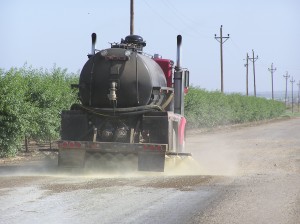
Dust is a problem in the Valley almost any summer, with our little-to-no rain and long hot days. But in this drought year, the problem is made worse with so much land sitting dry and unused, both agriculturally and residentially.
Along with exhaust fumes and wildfire smoke, dust contributes to poor air quality in the Valley. It contributes to the particulate matter, and adds to air pollution.
“We are definitely seeing an affect on air quality because of the dust from the drought with so much land lying idle,” said Jamie Holt, chief communications officer for the San Joaquin Valley Air Pollution Control District.
It isn’t just the idle agricultural land, but also the many lawns that are drying up and not watered, all adding to potential dust and particulate matter in the air, she said.
Dust, along with any other type of air pollutant, affects not only those with respiratory problems, but makes for unhealthy air quality for everyone, she added.
In Kings County, more than 200,000 acres of potential row cropland is not being utilized this year, said Diane Friend, executive director of the Kings County Farm Bureau. This is about 30% of farmland that would usually be planted with tomatoes, cabbage, garlic and onions, she said, adding that this land could produce more dust than the caring or harvesting of its usual crops.
Harvesting contributes to dust and air quality, and cotton and nut harvesting is scheduled to begin in the next couple of weeks.
Nut harvesting can be pretty bad no matter what the weather, said Elizabeth Fichtner, a University of California Cooperative Education farm advisor.
During harvesting, almonds and walnuts are shaken to the ground. Walnuts are immediately swept up from the floor of the grove by machines, while almonds sit for a few days before sweeping. Pistachios are also shaken, but into baskets for retrieval. All this shaking and sweeping can produce a lot of dust.
But, even if there were abundant water available, the ground would need to be dry for harvest. Moisture during harvest can cause major problems including mold, Fichtner said.
Harvesting aside, farmers have found alternate ways from water to help control dust problems.
“Some walnut growers are using crushed walnut shells on their farm roads to help keep the dust down,” Fichtner said.
And many growers of many different types of crops are looking at other alternatives such as an organic byproduct of salt, or magnesium chloride, called Dust-Off, said Gene Telese, marketing director for American Ag, which works throughout the southern area of the Valley.
Many farmers, who might have used water tankers in the past for dust control on roadways, are utilizing this alternative.
“Let’s just say it‘s been a very, very busy year,” Telese said.
The key is in the preparation of the area to be treated, he said. The product cannot be allowed to touch plants as it could potentially burn them during the application process itself. However, it dries quickly, within a day, so roads can be put back into use fast. And, it lasts for about three months, he added.
While oil is another possibility, it takes a long time to dry, up to 15 days or more. This means the roads must be idle during that time, Telese said.
Of course, when the air is idle, dust is not as much of a potential problem. For the past couple of months, it seems there has been a bit more wind, than average, said Brian Ochs, a meteorologist with the National Weather Service in Hanford.
“It is just my perception, that is has been a little more windy,” he said.
But, forecasts show “primarily high pressure for the rest of this month,” he noted, “which is more typical of what mid-summer brings, with little wind.”
With the air quiet, it is highly doubtful that there will be any one dust storm of any high magnitude. But it is best to remain mindful of the air quality, especially for those with any sensitivities or respiratory issues.
